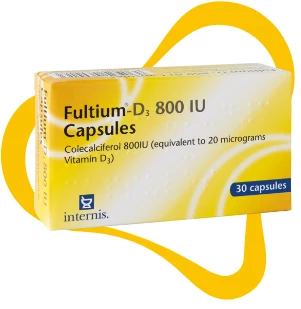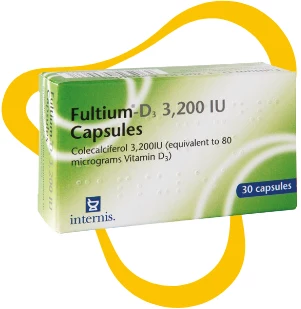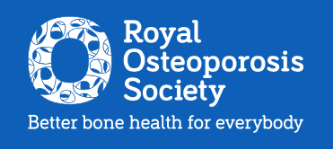




You (or your child) have been prescribed Fultium-D3.
This treatment guide explains what Fultium-D3 is, why you have been prescribed it, and how to take it to treat your condition.
This website is designed to support you with your treatment and is not a substitute for the Patient Information Leaflet that came with your medication.
If you have any worries about your treatment, it is important to talk them through with a member of your healthcare team. Do not stop taking this medicine unless your Healthcare Professional tells you to do so.
Please also be sure to read the Patient Information Leaflet that comes in the Fultium-D3 pack for full details on how to take the treatment.
What is Fultium-D3?
Fultium-D3 is used to prevent and treat vitamin D deficiency (that’s when the body does not have enough vitamin D). It is also prescribed in addition to specific osteoporosis treatment for people with vitamin D deficiency or at high risk of vitamin D insufficiency (a milder form of low vitamin D).1-4
Fultium-D3 is a medicine containing colecalciferol, another name for vitamin D3. As well as promoting healthy functioning of our muscles and immune system, sufficient vitamin D plays a critical role in bone health at all stages of life by helping our body to absorb calcium and phosphate, which are vital for building and maintaining strong bones.5,6 Getting enough vitamin D can help prevent bone conditions like rickets in children, as well as osteomalacia and osteoporosis as we age.5,6
What is rickets?
Rickets is a disease that disrupts bone growth in infants and young children. The main cause of rickets is a vitamin D deficiency.7 When children do not get enough vitamin D, their bones can become soft, weak, and unable to support their weight. This can result in fractures with little or no trauma, bone and muscle pain, and bony deformities such as bowed legs, curves of the spine and a jutting out breastbone.7
What is osteomalacia?
Osteomalacia is a bone-softening disease that occurs in adults. It results from a defect in the bone-building process and is usually caused by prolonged low levels of vitamin D.8
Bones are continuously being broken down and rebuilt. In osteomalacia, the bones are weakened because of a deficiency in the mineralisation phase of this process – the part where new bone tissue is hardened.8
Osteomalacia can cause widespread aching bone pain, often in the hips, along with muscle weakness which makes movement such as rising from a chair or climbing stairs difficult.8-10
Bones affected by osteomalacia are more prone to fractures, especially with minor injuries or stresses.6 In rare cases, bone deformities may also occur.8
What is osteoporosis?
Osteoporosis is a condition where bones become weak and fragile, making them break more easily.11
Bone is living tissue that is constantly being broken down and replaced. Osteoporosis occurs when the creation of new bone doesn’t keep up with the loss of your old bone.12,13
Imagine inside your bones is like a honeycomb. With osteoporosis, the holes in the honeycomb gradually become larger, making your bones become weaker over time.13
Most people don’t know they have osteoporosis until it causes them to break a bone. That’s why it is called a “silent disease”.13
Although fractures can occur in different parts of the body, the hip, wrist and spine are the most commonly affected sites.14
What happens if you have low vitamin D levels during pregnancy?
If you don’t have enough vitamin D when you’re pregnant, it can affect the health of your baby. This might mean your baby could be smaller than expected; they could be born too early; or they could have issues with bone and teeth growth.15 Rickets is one example. Low vitamin D during pregnancy is a major risk factor for rickets in babies.16 There’s also a higher chance babies of mums who have low vitamin D levels will get an infection.15
Why has Fultium-D3 been prescribed?
Very few foods naturally contain vitamin D. Instead, the body makes its own when skin is exposed to sun.5
How much vitamin D the skin makes depends on things like:17,18
- how much time you spend outside
- what time of day and what time of year it is
- how much of your skin is exposed
- whether you are wearing sunscreen
- how dark your skin is (people with darker skin have more melanin, which can reduce the skin’s ability to produce vitamin D from sunlight)
- how old you are (as we age, our skin becomes less efficient at producing vitamin D)
During the winter, something like 1 in 3 people in the UK have vitamin D levels below those recommended; even in the summer, it is still as high as 1 in 10.19
How do you take Fultium-D3?
Fultium-D3 is available as drops or capsules in a range of doses to support different patients’ needs.1-4 So it is very important to follow your doctor’s instructions closely as they will know what dose is right for you or your child.
 |
Daily drops: These can be used from birth onwards. Your doctor will tell you how many drops to take each day. Often, a larger dose is initially prescribed, followed by a smaller dose for ongoing use. You should collect the number of drops you or your child need on a spoon before taking them. Alternatively, you can add them to a small amount of food or a drink as long as it is cold or lukewarm, not hot. If you do that, it is very important that all the food or drink is consumed.1 |
 |
Daily 800 IU (blue-coloured) capsules: These can be used from 12 years upwards. Your doctor will usually prescribe a dose of 1-5 capsules daily for up to 12 weeks depending on how low your vitamin D levels are and how you respond to treatment. Your doctor will then tell you to take 1-2 capsules daily to keep your vitamin D levels stable. The capsules should be swallowed whole (not chewed) with water.2 |
 |
3,200 IU (green-coloured) capsules: For children over 12, adults and the elderly with severe vitamin D deficiency, your doctor will usually prescribe a dose of 1 capsule daily for up to 12 weeks. If you are vitamin D deficient when you are pregnant or breast feeding, your doctor will usually prescribe 1 capsule daily. The capsules should be swallowed whole (not chewed) with water.3 |
 |
20,000 IU (yellow-coloured) capsules: These can be used from 12 years upwards (but unlike the other Fultium-D3 options, 20,000 IU capsules are not recommended if you are pregnant or breast feeding). Follow your doctor’s instructions very carefully regarding how frequently you take treatment (it will be printed the label on your Fultium-D3 pack) as it will be different for different patients. If you are at all unsure, always check with your doctor or pharmacist. The capsule should be swallowed whole with water, preferably with the main meal of the day.4 |
Is Fultium-D3 suitable if you are vegetarian/vegan?
 |
Drops: The vitamin D3 in Fultium-D3 comes from lanolin from the wool of live, healthy sheep. So whether they’re okay for vegetarians depends on personal choice. Drops are not suitable for vegans because of this ingredient. |
| Capsules: These are not suitable for vegetarians or vegans since the capsule shell contains glycerol and gelatin from animal sources (beef). |
Is Fultium-D3 suitable for Kosher dietary requirements?
| The capsule shells contain gelatin. The gelatin is kosher certified. |
Is Fultium-D3 suitable for Halal dietary requirements?
| The capsule shells contain gelatin. The gelatin is halal certified. |
Is Fultium-D3 okay for people with allergies/food sensitivities?
| Drops and capsules: Fultium-D3 does not contain lactose, fructose, sucrose, eggs, soya, gluten or nuts.1-4 Please check the Patient Information Leaflet for the full list of ingredients. |
What should you do if you forget a Fultium-D3 dose?
 |
Drops: If you forget Fultium-D3 drops, they should be taken as soon as you remember. Do not take or give a double dose to make up for a forgotten dose. After that, the next drops should be taken according to the instructions given to you by your doctor.20 |
| Capsules: If you forget to take your capsules, take them as soon as you can. Do not take a double dose to make up for a forgotten dose. After that, take the next capsule according to the instructions given to you by your doctor.21-23 |
What should you do if too much Fultium-D3 is taken by mistake?
 |
Drops: If you accidentally take/give one drop too many, it’s usually harmless. However, if several drops too many are taken, seek immediate medical advice. Bring the drops and their packaging with you to show the doctor/pharmacist. Taking too many drops may result in feeling or being sick, becoming constipated or having stomach pains, weak muscles, tiredness, a lack of appetite and feeling thirsty.1 |
 |
800 IU (coloured blue) and 3,200 IU (coloured green) capsules: If you accidentally take one capsule too many, it’s usually harmless. However, if you take several capsules too many, seek immediate medical advice. Bring the capsules and their packaging with you to show the doctor/pharmacist. If you take too many capsules you may feel or be sick, become constipated or have stomach pains, weak muscles, tiredness, a lack of appetite or feel thirsty.2,3 |
 |
20,000 IU (coloured yellow) capsules: If you accidentally take too many capsules, seek immediate medical advice. Bring the capsules and their packaging with you to show the doctor/pharmacist. If you take too many capsules you may feel or be sick, become constipated or have stomach pains, weak muscles, tiredness, a lack of appetite or feel thirsty.4 |
Does Fultium-D3 have side effects?
Side effects are always a possibility with any kind of medication. So while not everyone does suffer side effects, there’s a chance you may do. You will reduce the chance of these effects if you take your medicine exactly as instructed.
Side effects with Fultium-D3, which are uncommon, include too much calcium in your blood. This can make you feel or be sick, lose your appetite, have constipation or stomach-ache, feel very thirsty, have muscle weakness, drowsiness or confusion. Rare side effects, affecting less than 1 in 1000 people, may include skin rash, itching, and hives.1-4
Be sure to read the Patient Information Leaflet that comes with your medication for further details on possible side effects.
If you experience any side effects, talk to your Healthcare Professional. This includes any possible side effects not listed in the package leaflet. You can also report side effects directly via the Yellow Card Scheme at https://yellowcard.mhra.gov.uk.
Where can I find out more about bone health?
If you would like more information about vitamin D and bone health, or want to talk to someone about your condition, the Royal Osteoporosis Society has a helpline staffed by specialist nurses. You can give them a call on 0808 800 0035 or send an email enquiry to nurses@theros.org.uk

We are proud to be a partner of the Royal Osteoporosis Society.
Take 5 minutes to check your bone health risk using the Royal Osteoporosis Society’s risk checker
References
- Fultium-D3 Drops Summary of Product Characteristics.
- Fultium-D3 800IU Capsules Summary of Product Characteristics.
- Fultium-D3 3200IU Capsules Summary of Product Characteristics.
- Fultium-D3 20KIU Capsules Summary of Product Characteristics.
- National Institutes of Health. Available at: ods.od.nih.gov/factsheets/VitaminD-Consumer/ Accessed on: 07.11.23.
- Sizar O et al. StatPearls 2023. Available from: www.ncbi.nlm.nih.gov/books/NBK552366/ Accessed on: 07.11.23.
- Dahash BA, Sankararaman S. StatPearls 2023. Available from: www.ncbi.nlm.nih.gov/books/NBK562285/ Accessed on: 07.11.23.
- Zimmerman L, McKeon B. StatPearls 2022. Available from: www.ncbi.nlm.nih.gov/books/NBK551616/ Accessed on: 07.11.23.
- Uday S, Högler W. Indian J Med Res 2020; 152(4):356-67.
- National Library of Medicine (US) 2022. Available at: medlineplus.gov/ency/article/000376.htm Accessed on: 07.11.23.
- Dimai HP, Fahrleitner-Pammer A. Best Pract Res Clin Rheumatol 2022; 36(3):101780.
- Porter JL, Varacallo M. Available at: www.ncbi.nlm.nih.gov/books/NBK441901// Accessed on: 06.11.23.
- National Institute on Aging. Available at: www.nia.nih.gov/health/osteoporosis Accessed on: 06.11.23.
- Gopinath V. Med Clin North Am 2023; 107(2):213-25.
- Karras SN et al. Ther Adv Musculoskelet Dis 2016; 8(4):124-35.
- Kanike N et al. Nutrients. 2020; 12(7): 2085.
- Tsiaras WG, Weinstock MA. Acta Derm Venereol 2011;91(2): 115-24.
- Bocheva G et al. Int J Mol Sci 2021; 22(16): 9097.
- Calame W et al. Nutrients 2020: 12(6): 1868.
- Fultium-D3 drops. Patient Information Leaflet.
- Fultium-D3. 800 IU capsules. Patient Information Leaflet.
- Fultium-D3. 3,200 IU capsules. Patient Information Leaflet.
- Fultium-D3. 20,000 IU capsules. Patient Information Leaflet
Reporting of side effects. If you get any side effects, talk to your doctor, pharmacist or nurse. This includes any possible side effects not listed in the package leaflet. You can also report side effects directly via the Yellow Card Scheme at https://yellowcard.mhra.gov.uk. By reporting side effects, you can help provide more information on the safety of this medicine.
UK-FULT-90(1) | Date of Preparation February 2024



